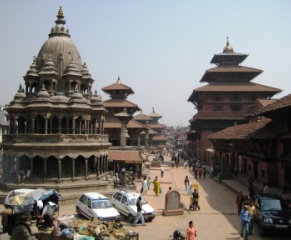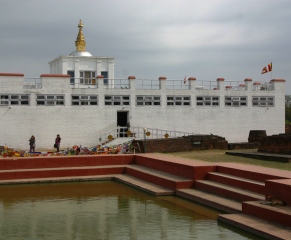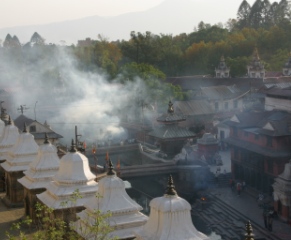There are many places in Nepal which are famous for sight seeing. These places have some historical as well as geographical importance. Some of these famous places to visit in the Kathmandu Valley are:
Kathmandu Valley
The Kathmandu valley, the political, commercial cultural hub of Nepal is famed for its natural beauty and history, holistic place. Once a separate kingdom in itself, it contains three fabled cities, Kathmandu, Patan and Bhaktapur. Each is an artistic exposition of graceful temples, elegant palaces, brick paved courtyards and quaint streets. As a whole, the valley is surrounded by tier upon tier of green mountain walls above which tower mighty snow capped peaks. The valley is rich in places of pilgrimage for both Hindus and Buddhists. Both of their deities well side by side by both Tantric symbolism and ancient animistic beliefs.
Kathmandu Durbar Square
Duly recognized as a world Heritage site by UNESCO, this particular area best known as Kathmandu Durbar Square lies in the heart of this city. The locals know this area by its old name "Hanuman Dhoka" Palace Square an ancient seat of the Nepalese Royalty.
Hanuman Dhoka Palace complex consists of a huge Royal Square exposing a tremendous variety of temples dedicated to different Hindus gods and goddess. Most of the buildings we see here date from 15th to 18th century.
Swayambhunath Stupa
Three kilometer west of Kathmandu city complex locates the one of the worlds most glorious Buddhist Stupa, it is said to be 2.000 years old. Visitors often call it ‘Monkey Temple’. The main structure brick and clay which supports a lofty conical spire capped by a pinnacle of copper gilt. There are the all-seeing eyes of Lord Buddha on the four sides of spire. Being situated seventy meter above the level of valley, the hill of Swayambhunath is a mosaic of small stupa and pagoda temples. Aside, in front of the temple, one of the famous goddess with the shrine of Ajima called ‘Harati Mata’ is there. This temple of goddess believes to be famous in the way of tantric. Both the stupa of Lord Buddha and temple of a goddess are surrounded by other temples and Tibetan monasteries. Being located in the top level of valley, this place is famous for visitors for sightseeing.
Pashupatinath Temple
Pasupatinath temple being the temple of Lord Shiva possessed its two-storied golden roof and silver doors and is famous for its superb architecture. The temple is situated 5 kilometer east of Kathmandu heart, on the banks of sacred Bagmati River. Being one of the most important Hindu temples, this is a center of annual pilgrimage. From time immortal, the Pasupatinath area has contained numerous temples, stupa, monasteries, images and inscriptions. Not only is the Pasupatinath area a pilgrimage site for the Hindus and it is also an important cultural treasury for the whole world. Only Hindus are permitted to enter from the main gate.
Bouddhanath Stupa
One of the oldest and the biggest Buddhist monuments ever built in Nepal,Bouddhanath is an imposing structure standing some 36 meters. The Stupa stands on the massive three level Mandala style platform surrounded by colorful private family houses. The basic feature of this great stupa is very much like those of Swayambhunathstupa except its finial displaying. It is much bigger than SwayambhunathStupa and lies on the valley floor where s former one stands on the hilltop. This stupa is said to have been built in 5th century AD.
Patan Durbar Square
Patan located on lovely little plateau across the Bagmati is only 7 km southeast of Kathmandu. This city roughly inhabited by some 125000 people in considered oldest of all three cities of Kathmandu valley. This city founded in 3rd century AD. By King VeeraDev has a finest Newar crafts since time immemorial. Meaning the city of fine arts has hundreds of fascinating Hindu and Buddhist monuments scattered in and around. The most important monument area of course is Patan Durbar Square. Recognized by UNESCO as a world heritage site. The Square has been described as one of the most picturesque collection of buildings that have been set up so small a place by the piety of oriental man. Most of the monuments in this square date back to the medieval Malla period 15th to 17th century as the golden period of Nepalese art and architecture. The important things to be seen in this area include the Golden Gate and the Golden Window of the old Palace, the beautiful piece of traditional metal crafts, the famed Krishna temple with 21 golden pinnacles, the Royal bath of Sundarichowk, a perfect piece of the classic work in stone. Royal Taleju temple, ViswaNath Temple and Char Narayan temple are the finest examples of the unique craftsmanship in wood; the temple of Bhimsen with the magnificent golden balcony overlooking the square outside plus many other shrines and sculptures scattered in and around the square.
Bhaktapur Durbar Square
Situated at an altitude of 1.401 meter above sea level Bhaktapur only is a very unique old town. This city divided into 24 traditional locality covers an area of 5 square kilometers. Founded by King AnandDev in 889 AD Bhakatapur is said to have been built in the shape of conch shell a sacred symbol of Lord Vishnu. The word Bhaktapur means the city of devotees. Before the unification of Nepal, Bhaktapur was an independent principality ruled by the Malla Kings, who were very much devoted to religion, culture and art. During the period many magnificent temples and mansions were built. This period is remembered as golden period in the Nepalese art and remains a unique example.
Changu Narayan Temple
The temple of Changu Narayan situated on the hillock of Dolagiri to the north of Bhaktapur is one of the oldest temples in Nepal. Situated at an altitude of 5.000ft. This temple has its distinct historical and architectural significance. The most authentic and oldest ever inscription is located in the precinct of Changu Narayan. The oldest inscription dated 464 AD is a credited to have been set up by Lichchshavi King Manadeva. The erection of Garuda Piller by Manadeva is expression of his devotion and reverence to Chang Narayan as learnt from the inscription, points that the temple of Changu Narayan was built sometime before 464 AD.
Nagarkot
There are various places around the edge of the Kathmandu Valley which offer great mountain views, but the resort village of Nagarkot is generally held to be the best mountain watchers make their way up to the village, stay overnight in one of Nagarkot's lodges or hotels than rise at dawn to see the sun appear over the Himalayas.
Nagarkot is popular tourist resort of Nepal. It is situated 32 Kilometers east of Kathmandu at an altitude of 2.175m above the sea level. The panorama of the major peaks of eastern Nepal Himalayas including Mt. Everest can be seen from here. Himalayan peaks like Manaslu (8.463m) Ganesh Himal (7.111m) Langtang (7.246m) Gaurishanker (7.134m) can also clearly seen from Nagarkot. A motor able road links Nagarkot with Bhaktapur.
Pokhara
Pokhara valley is situated at an altitude of 827 meters above the sea level and is 200 kilometers west of Kathmandu valley. Prithivi Raj Marga is the highway linked with by Bhairahawa by Siddhartha Raj Marga (Sunauli border) It is a combination of the long arrays of world famous snow clad peaks, emerald lakes, turbulent rivers with deep Georges and picturesque villages inhabited by Magar, Gurungs and Thakalis. Pokharaoffers the magnificent views of Dhaulagiri, Manaslu, Machhapuchhare, five peaks of Annapurna Himalayas and others. Pokhara numerous lakes known as "Tal" in Nepal offer fishing, boating and swimming, which ensure the famous Phewa, Begnas and Rupa lakes of Pokhara. Pokhara is also referred as the center of adventure. It is the starting point for most of the popular trekking & rafting destination. The serenity of Phewa lake and the magnificence of Machhapuchhare (6.977m) rising behind it, creates an ambiance of peace and magic.
Phewa lake
is situated at an altitude of 784m above sea level with an island temple at the middle of the lake. It is second largest lake in the kingdom. Temple situated at the island is the two storied pagoda dedicated to the boar magnification of Ajima. The reflection of Mt. Machhapuchhare and Annapurna can be seen in its serene water. Thick forest lies on the adjoining southern slopes of the lake.
Davi's fall locally known Patale Chhango in the southern flank of the Pokhara valley is where the stream flowing from Phewa lake collapses and surges down the rock into a deep gage, leaping through several potholes.
Mahendra cave lies at the north of the Pokhara valley. It is a large limestone cave which is one of the few stalagmites stalactite caves found in Nepal.
Tibetan Village Tashiling in the south and Tashii Palkhel in the north of Pokhara valley is the two Tibetan village which is inhabitant by the Tibetan people who keeps themselves busy by producing and trading woolen carpets and other handicrafts.
Museum: One museum display the life styles and history of the Gurungs, Thakalis and Tharu and other one Natural history museum and is functioned by the Annapurna Conservation area project. Butterflies, insects, birds and wild life found in the Annapurna region.
Mountains Views: Spectacular Panorama of the Annapurna range forms the backdrop of Pokhara valley. The mountains stretching from east to west includes Annapurna I to IV. It lies at the distance of 40kms from the valley and at the elevation of 900m. Among these Annapurna. Annapurna I (8.091m high is the highest peak. Mt. Machhapuchhare with its pyramid shape dominated all the other neighboring Peaks. The other peaks are Mt. Dhaulagiri 8.167m, Lamjung Himal 6.983m and Manaslu 8.163m and Himalchuli.
Barahi Temple: This is the most important religious monument in Pokhara. Built almost in the middle of Phewa Lake, this two-storied pagoda is dedicated to the boar manifestation of Ajima, the protectors deity representing the female force Shakti. Devotees can be seen, especially on Saturday, carrying male animals and fowl across the lake to be sacrificed to the deity.
World Peace Pagoda a massive Buddhist Stupa, is situated on top of a hill on the southern shore of Phewa Lake. Besides being an impressive sight in itself, the shrine is a great vantage point which offers spectacular views of the Annapurna range and Pokhara city. You can get there by crossing the lake by boat and then hiking up the hill.
Lumbini

Lumbini is the birth place of Lord Buddha, the apostle of peace and compassion. It is 21 km west of Bhairahawa and 285 km southwest of Kathmandu. It is a place of pilgrimage for Buddhist as well as place of reverence for peace lovers of any religious faith throughout the world. In Lumbini the central attraction is the sacred garden with Maya Devi temple depicting the birth of Lord Buddha, Ashoka Pillar pinpointing the birth place of Buddha and Shakya Tank where Maya Devi, the mother of Lord Buddha, is supposed to have taken a dip before bringing forth the baby - Lord Buddha. Around this holy site, there are remnants of Monasteries and Chaityas built over the centuries following Buddha's birth in 632 BC.
The work is underway at Lumbini to transform three square miles of flat, empty land into an expression of Buddha's peace and compassion creating a sculpted landscape to make the teaching of Lord Buddha accessible to all humanities. The project area designed on a north-south axis encompasses three zone each covering one square mile. The Lumbini village lies as a gateway to the outer world. The second zone, on either side of a canal and walkway will be developed into a monastic enclave where nations, institutions and organization can build places of worship that reflect varying religious ideals and styles. A meditation center will be the highlight of this zone. The third and most important zone is the sacred garden itself where the beauty of its plant life will be restored to create a reverent atmosphere in which one can experience Buddha's universal message.




